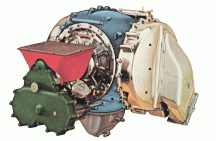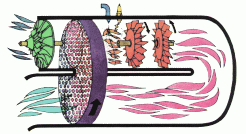

 The turbine engines that Chrysler designed for automotive use are based on
the same principals as turbine engines used in aviation. The biggest
design difference is the addition of regenerators. The regenerators are
rotating heat exchangers that recover heat from the exhaust and use it to
heat air entering the combustion chamber. The basic components of the turbine engine are a
compressor, two sets of turbine blades (one to run the compressor and the
other to drive the output shaft), fuel delivery, and ignition. As the
turbine spins, it drives the compressor blades to compress incoming air.
The compressed air is combined with fuel and ignited to drive the turbine
blades. Unlike piston engines, the combustion process in a turbine is
continuous. As a result, turbines can run on a variety of fuels such as
gasoline, diesel, kerosene, and aviation jet fuel.
The turbine engines that Chrysler designed for automotive use are based on
the same principals as turbine engines used in aviation. The biggest
design difference is the addition of regenerators. The regenerators are
rotating heat exchangers that recover heat from the exhaust and use it to
heat air entering the combustion chamber. The basic components of the turbine engine are a
compressor, two sets of turbine blades (one to run the compressor and the
other to drive the output shaft), fuel delivery, and ignition. As the
turbine spins, it drives the compressor blades to compress incoming air.
The compressed air is combined with fuel and ignited to drive the turbine
blades. Unlike piston engines, the combustion process in a turbine is
continuous. As a result, turbines can run on a variety of fuels such as
gasoline, diesel, kerosene, and aviation jet fuel.
For automotive use, Chrysler used reduction gears to bring the output RPM's down to the same range as piston engines. In all of Chrysler's applications involving turbine engines, they were coupled with conventional automatic transmissions. The exhaust systems of turbine powered cars were nothing more than large ducts running under the chassis.
| CR1 | 54-56 | Plymouth Belvedere 4-door ~100 HP Poor fuel economy (13-14 MPG) No engine braking Slow spool up |
| CR2 | 56-57 | 56 Belvedere, 57 Fury Better regenerator Better fuel economy (18 MPG) |
| CR2A | 60-61 | 60 Fury, 62 Fury(2), 62 Dart(2) 61 Dodge 2 1/2 ton stake Turboflite show car. 140 HP, 375lb-ft, adjustable nozzle blades |
| A831 | 63-66 | 63 Turbine Cars (50) 130 HP, 425 lb-ft much less lag. |
| A874 | 64 | 64 Plymouth(2) Same as A831 but with larger regenerators. |
| Gen6 | 64-73 | Prototype Charger, 66 Coronet 73 B-Body sedans(3) Same as A875 but with split accessory drive. |
| Gen7 | 77 | 76 4-door Aspen, Concept F-body 80 Mirada 104 HP (could be raised to 125) |
You can send me mail at:dougc@fourforty.com